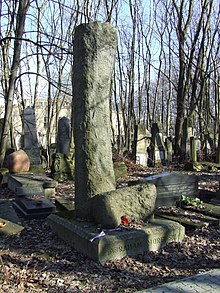Abraham Morewski

Abraham Morewski in German films also as Avrom Morewski (born March 18, 1886 in Vilnius , Russian Empire ; died October 3, 1964 in Warsaw ) was a Polish actor , director , writer, translator of Jewish origin.
Life
Morewski was born in Vilnius as the son of Benjamin Menakieras. He graduated from the Alexei Sergeyevich Suvorin Acting School. He began his acting career in various theaters in Russia , including St. Petersburg . In 1917 he published a study on Shylock and Shakespeare. In 1918 he returned to Vilnius, where he played in local Jewish theaters. He became a member of the Vilna troupe , with whom he was a guest performance in Vienna in 1922 and directed Perez Hirschbein's play Die puste krejtschme . In the interwar period he played in theaters in Warsaw and in German films.
In 1937 he played the tzaddik Asriel in the film The Dybbuk and garnered positive reviews. During the Second World War he fled to the Soviet Union and lived in the Central Asian republics.
In 1956 he returned to Poland and settled in Warsaw. In the same year he took part in the State Jewish Theater. He published a four-volume treatise.
He was awarded the Order of the Rebirth of Poland . Morewski was married twice. His first wife was called Anna, the second was the Warsaw pianist Maria Lengner (1899–1968).
Morewski was buried in the Jewish cemetery on Okopowa Street in Warsaw. His tombstone was designed by the artist Stanisław Kulon.
Fonts
- Ahin un aher . 1963
- “Roles” and “Direction” in An-sky's “Dybuk” in Das Zelt. Jewish illustrated monthly , 1 (1924), no. 5, pp. 183-186
Filmography
In the German films he plays as Avrom Morewski .
- 1923: The old law
- 1925: The Tower of Silence
- 1936: Al Khet (Polish: Za grzechy )
- 1937: The Dybbuk (The Dibbuk)
Web links
- Abraham Morewski in the Internet Movie Database (English)
- www.yivoencyclopedia.org Avrom Morevski at www.yivoencyclopedia.org (English)
Individual evidence
- ↑ 22nd international forum for young films berlini992 - DER DIBEK / DYBUK.
- ↑ Armin A. Wallas (Ed.): Eugen Hoeflich. Diaries 1915 to 1927 . Vienna: Böhlau, 1999 ISBN 3-205-99137-0 , p. 449ff.
- ↑ Grób Marii Morewskiej
- ↑ Grób Abrahama Morewskiego
| personal data | |
|---|---|
| SURNAME | Morewski, Abraham |
| ALTERNATIVE NAMES | Morewski, Avrom (in German films); Menakiera (maiden name) |
| BRIEF DESCRIPTION | Polish actor |
| DATE OF BIRTH | March 18, 1886 |
| PLACE OF BIRTH | Vilnius |
| DATE OF DEATH | 3rd October 1964 |
| Place of death | Warsaw , Poland |
